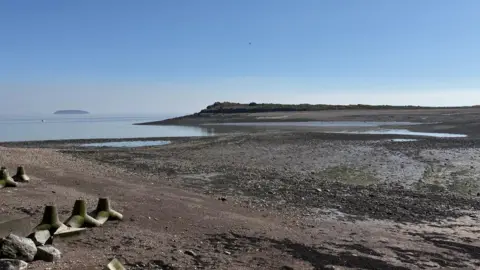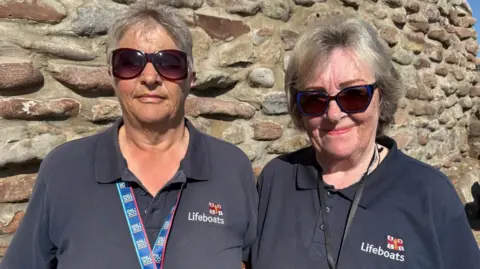Beach visitor warning over danger of incoming tide
 BBC
BBCVisitors to the coast during the Easter holidays are being urged to be careful after a number of people had to be rescued after getting cut off by spring tides.
The RNLI has rescued eight people from Sully Island off the coast of Barry, Vale of Glamorgan, in the past week which is an area with fast-rising tides and akin to "a great big bath filling up rapidly and draining rapidly".
The charity said a survey by Bangor University suggested about 15% of people had been cut off by the tide.
It also said almost 8% of callouts in Wales over the past decade were for people getting cut off by the tide - more than double the UK average.
Once the causeway to Sully Island is submerged, people cut off may be stranded for up to six hours.
This means some may be tempted to swim back, which is being described as "a dangerous decision" in fast-moving water.
To help reduce incidents, the RNLI Sully Island water safety team will begin their patrols from Easter weekend.
Anna Snow, RNLI water safety officer, said the area had the "second largest tidal range in the world next to Bay of Fundy in Canada".
This means 10-11m (33-36ft) of water "rushing in within six hours and rushing out again".
Ms Snow explained how the narrow channel between Sully Island and the mainland acts like a funnel and, although it may appear calm as the tide rises, water can surge through at up to 7 knots (8mph).
She said, even when the incoming water was only knee high, "it will knock you off your feet".

The RNLI also said a gap in coastal safety knowledge was especially worrying as spring tides will happen across the country during the school Easter break when beaches are typically busy.
With the return of patrols, volunteers will monitor the entrance of the causeway for a second year running during primary tidal cut off periods.
Anne Gripton and Lee O'Brien are RNLI volunteers based at Sully and tell people when they cannot cross.
Ms Gripton said: "There are other areas of the coastline where the water won't come in as quick but that's why it's so dangerous here."
Lee added: "It'll knock you down, it's fast and strong and within less than an hour you'll be four miles away."

One of the key findings of the survey of 1,368 people by Bangor University was the speed of the incoming tide.
About 60% of those who had been cut off by the tide were shocked at the speed they had become stranded.
The research also showed that four in ten people had no basic understanding of the tides and only half claimed to check tide times before visiting a beach.
A quarter (24%) of those asked could read and interpret a tide timetable in order to take the appropriate action to prevent being cut off.
Dr Liz Morris-Webb, honorary research fellow at Bangor University said: "As so many people enjoy the benefits our coast has to offer, it is maybe not surprising that 15% of the population has at some point been cut off by the tide, or nearly so.
"The first-hand experiences of those who have been cut off have provided important lessons on gaps in tidal knowledge that can quickly turn a family walk or beach visit into to life-threatening situation."
